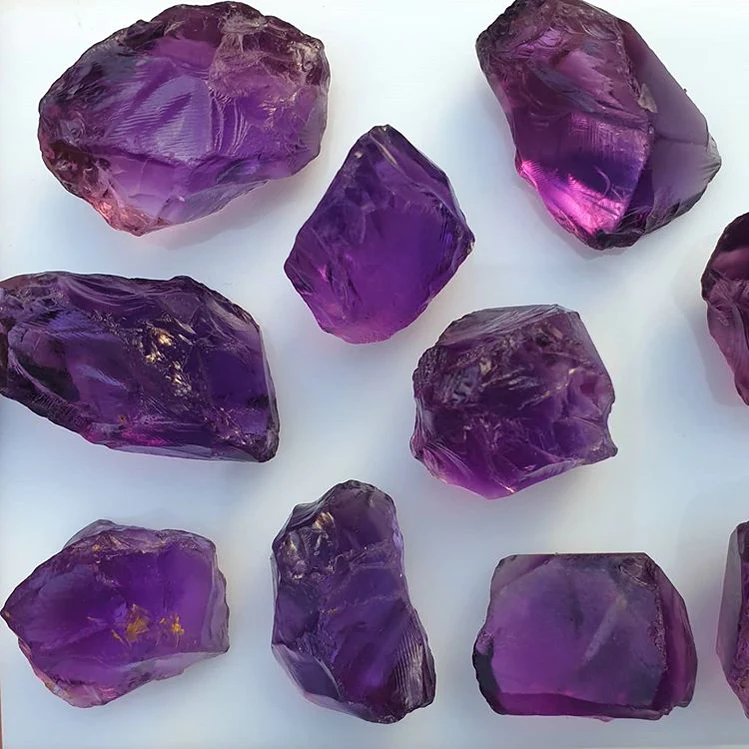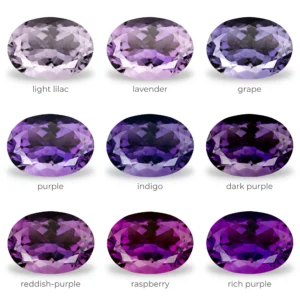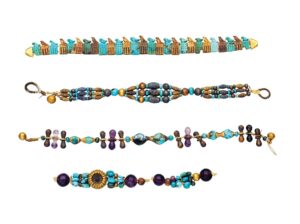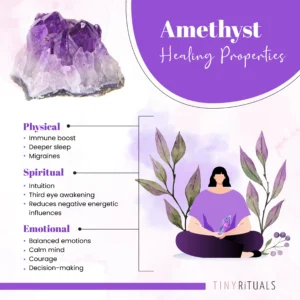FEBRUARY: The birthstone for this month is amethyst
February is often a cold, dark, and short month for many people around the world. Amethyst is a gorgeous, richly-colored gemstone, which is a beautiful contrast to this time of year.
Amethyst is the purple variety of Quartz that has fascinated gem lovers for over a millennium due to its mythical powers and stunning beauty. Amethyst has always been thought to be a royal gemstone since the time of the Romans and Greeks. That is why it can be found in the collections of royal families throughout Europe and Asia.
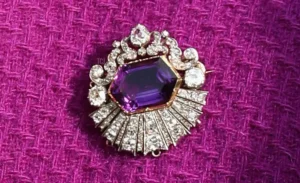
Royal Purple Amethyst Brooches for queen Elizabeth
Discover the enchanting world of Amethyst, a globally beloved gemstone with a stunning range of colors – from delicate lilacs to deep plums, adorned with hints of red, blue, and rich browns. Popular varieties like Chevron Amethyst, Brandberg Amethyst, Rutilated Amethyst, and Ametrine offer unique patterns and hues, adding to the gem’s allure.
Uncover the beauty of Amethyst and its diverse varieties, making it a sought-after gem for enthusiasts and collectors alike. Explore the vibrant spectrum and distinctive characteristics that make Amethyst a captivating choice in the world of gemstones.
The deeper colors are the most precious with strong reddish-purple or deep purple with no color variation throughout the stone. Siberian Amethyst from Russia and Rose de France from brazil, are better examples showing even color throughout. With the correct cutting, this gem can display dramatic color changes from red to blue when viewed from different angles.
Note: Amethyst crystals are sensitive to sunlight; if they are exposed for too long, the color can fade considerably, and this cannot be reversed.
“Amethyst Gemstone: Unveiling Its Fascinating History, Royal Connections, and Enduring Charm”
“Embark on a captivating journey through history as we unravel the tale of Amethyst, a gemstone with a legacy that spans centuries. Derived from the Greek word ‘amethystos,’ meaning ‘not intoxicated,’ Amethyst was believed in ancient times to protect against drunkenness and enhance mental clarity.
In ancient Egypt, Amethyst held a sacred significance, featuring prominently in burial rituals and royal jewelry. The gemstone was associated with protection and believed to instill a sense of calmness and balance.
During the Middle Ages, Amethyst adorned clergy members, symbolizing piety and sobriety. Its royal purple hues became a mark of high regard, gracing ecclesiastical rings and crosses.
The Renaissance era further elevated Amethyst’s status, becoming a favorite among European royalty and nobility. Its regal color symbolized luxury and elegance.
In 1901, an intriguing chapter was added to Amethyst’s history when Egyptian workers clearing the tomb of Pharaoh Djer made a gruesome discovery. An arm was found stuck inside a hole, with wrappings that, when unraveled, revealed four bracelets made of gold, turquoise, lapis lazuli, and amethyst. These artifacts are now on display in the Cairo Museum.
In the 19th century, significant Amethyst deposits were discovered in Brazil, marking a new chapter in its history. The gemstone’s accessibility grew, gaining popularity during the Victorian era in various jewelry designs.
Today, Amethyst continues to be cherished for its stunning beauty and timeless appeal. From its roots in ancient beliefs to its prominence in various cultures and eras, Amethyst remains an enduring symbol of grace and sophistication. Explore the rich history of Amethyst, a gemstone that has captivated hearts across generations and stands as a testament to its timeless charm in the world of jewelry.”
The modern name amethyst arises from the ancient Greek word amethystos, meaning a remedy against drunkenness. Ancient predecessors believed that if you wore an amethyst, it would protect you from getting drunk.
Amethyst is an ideal gemstone to wear; people wear amethyst as a symbol of personal empowerment and inner strength (mental and physical peace) as well as it is also believed to induce peace, serenity, and temperance in you, plus it will restrict sensual and alcoholic intoxication.
Amethyst Associations:
Chakras
Crown Chakra, Third Eye Chakra Birthstone
February Zodiac
Aquarius, Capricorn, Virgo, Pisces, Sagittarius Anniversary
6th Hardness
7 Planet
Jupiter Color
Reddish-violet tints of pale or almost colorless shades and deep, rich tones of pure violet Healing Properties of Amethyst:
Increases nobility, Inner peace and healing, Positive transformation, Balance, Relieves stress, Courage, Communication.
Influence of Amethyst on People:
- Amethyst is a robust and shielding stone; it protects the wearer from all types of harm, such as electromagnetic stress and evil wishes from others.
- It is excellent for balancing mood swings; moreover, it relieves stress and strain, soothes irritability, dispels anger, rage, fear, and anxiety.
- It helps you become more focused, enhancing memory and improving motivation.
- It encourages you to dream and assists in remembering and understanding dreams.
- It fights against cancer by strengthing the immune system, cleanses the blood, and enhances the body to bear less pain.
- Amethyst treats diseases of the lungs and respiratory system, skin conditions, and cellular disorders.
- Astrologists recommend amethyst for overcoming financial stress, professional instability, and unhealthy addictions.
Other Birthstone for February: Eleven different stones listed as birthstones for the calendar month of February, depending upon star position, planetary, or talismanic stones for the Zodiac sign of Aquarius or Pisces.
Stones Association Amethyst Modern Birthstone Bloodstone Mystical February Birthstone Garnet Aquarius & Pisces (Star Sign) Turquoise Aquarius (Planetary Stone) Agate Aquarius (Star Sign) Opal Aquarius (Star Sign) Jasper Aquarius (Talismanic Stone) Rock Crystal Pisces (Star Sign) Sapphire Pisces (Star Sign) Aquamarine Pisces (Planetary Stone) Ruby Pisces (Talismanic Stone)
Frequently asked questions (FAQs)
1. What is Amethyst?
- Amethyst is a violet to purple variety of quartz and is a popular gemstone known for its stunning color.
2. What is the meaning of the name “Amethyst”?
- The name “Amethyst” is derived from the Greek word “amethystos,” which translates to “not intoxicated.” In ancient times, it was believed to protect against drunkenness.
3. What are the different colors of Amethyst?
- Amethyst comes in a range of colors, from delicate lilacs with pink undertones to deep plums and raspberries with hints of red and blue, and even rich brown variations.
4. Are there different varieties of Amethyst?
- Yes, Amethyst has several popular varieties, including Chevron Amethyst, Brandberg Amethyst, Rutilated Amethyst, and Ametrine. Each variety has unique characteristics and patterns.
5. What historical significance does Amethyst hold?
- Amethyst has a rich history, from being associated with protection in ancient Egypt to symbolizing piety and sobriety during the Middle Ages. It was also favored by European royalty during the Renaissance.
6. Can you share a unique historical discovery related to Amethyst?
- Certainly! In 1901, during the clearing of Pharaoh Djer’s tomb in Egypt, workers discovered four bracelets made of gold, turquoise, lapis lazuli, and Amethyst, now on display in the Cairo Museum.
7. Is Amethyst used for healing purposes?
- Some people believe that Amethyst has healing properties, promoting calmness, balance, and clarity. However, it’s essential to note that these claims are often based on alternative or metaphysical beliefs.
8. Where is Amethyst mined?
- Amethyst is found worldwide, with notable deposits in Brazil, Africa, Russia, and the United States.
9. How can I care for my Amethyst jewelry?
- To care for Amethyst jewelry, avoid exposure to harsh chemicals and extreme temperatures. Clean it with a soft cloth and mild soap, and store it separately to prevent scratches.
10. Can Amethyst be used in engagement rings?
- Yes, Amethyst is a durable gemstone and can be used in engagement rings. Its unique colors make for a distinctive and meaningful choice for those seeking an alternative to traditional gemstones.
11. What makes Amethyst popular in modern jewelry?
- Amethyst’s popularity in modern jewelry is attributed to its captivating colors, historical significance, and versatility in various designs. It remains a sought-after gemstone for both casual and elegant jewelry pieces.


